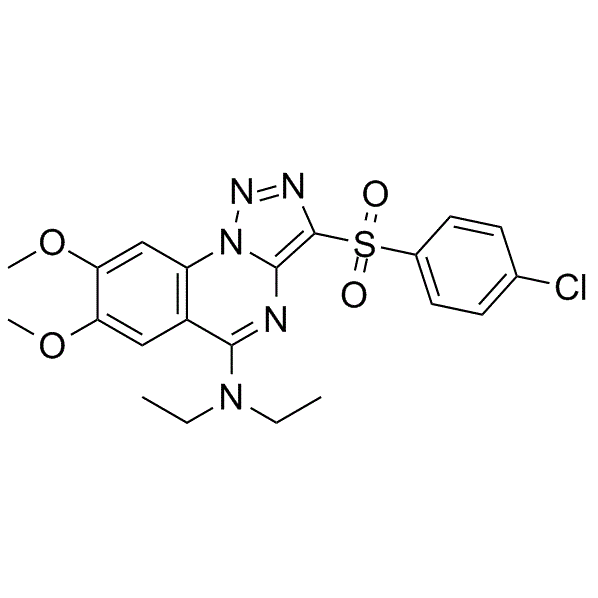| Cas No.: | 1200443-21-5 |
| Chemical Name: | 3-((4-chlorophenyl)sulfonyl)-N,N-diethyl-7,8-dimethoxy-[1,2,3]triazolo[1,5-a]quinazolin-5-amine |
| SMILES: | COC1=CC2=C(C=C1OC)C(N(CC)CC)=NC3=C(S(=O)(C4=CC=C(Cl)C=C4)=O)N=NN32 |
| Formula: | C21H22ClN5O4S |
| M.Wt: | 475.95 |
| Purity: | >98% |
| Sotrage: | 2 years -20°C Powder, 2 weeks 4°C in DMSO, 6 months -80°C in DMSO |
| Description: | Targocil functions as a bacteriostatic inhibitor of wall teichoic acid (WTA) biosynthesis which can inhibit the growth of methicillin-susceptible S. aureus (MSSA) and methicillin-resistant S. aureus (MRSA) with MIC90s of 2 μg/ mL for both MRSA and MSSA. |
| Target: | MIC90: 2 μg/mL (MSSA), 2 μg/mL (MRSA)[1] |
| In Vitro: | MICs of Targocil against S. aureus strains Newman, MW2, MG2375, and MG2389 are 1 μg/mL for all strains. Targocil shows excellent activity against S. aureus isolates from suspected cases of bacterial keratitis, including both MSSA and MRSA isolates, with MICs that range from 1 to 2 μg/ mL. Targocil, a derivative of 1835F03, exhibits better activity against all keratitis isolates than the original lead compound, 1835F03. Bovine serum exhibits a detectable but moderate inhibitory effect on the in vitro antimicrobial activities of both 1835F03 and Targocil, increasing the MICs of both by 4- to 8-fold. Compare to the vehicle alone, Targocil at 5 μg/mL exhibits little toxicity for HCECs, even after 24 h of exposure. However, 40 μg/mL Targocil shows toxicity at all time points tested. Targocil at levels equal to 10×MIC in vitro readily inhibits growth of Newman and MG2375 in the presence of HCECs[1] |
| Cell Assay: | Log-phase strains MG2375, MG2389, Newman, and MW2 are collected and adjusted to a concentration of 2×108 CFU/mL. After the treatment of bacterial cultures with Targocil at 10×MIC for 1 h, the cells are diluted 1:1,000 in fresh medium and then incubated and plated at the appropriate time points for viability determination. The postantibiotic effect (PAE) is calculated by the standard equation T-C, where T is the time required for the CFU count in the test culture to increase 10-fold above the count observed immediately after drug removal, and C is the time required for the count of the untreated control to increase 10-fold under the same conditions[1]. |
| References: | [1]. Suzuki T, et al. In vitro antimicrobial activity of wall teichoic acid biosynthesis inhibitors against Staphylococcus aureus isolates. Antimicrob Agents Chemother. 2011 Feb;55(2):767-74. |

 DC Chemicals' products qualify for U.S. tariff exemptions. We guarantee no price increases due to customs duties and maintain stable supply, continuing to deliver reliable research solutions to our American clients.
DC Chemicals' products qualify for U.S. tariff exemptions. We guarantee no price increases due to customs duties and maintain stable supply, continuing to deliver reliable research solutions to our American clients.





















